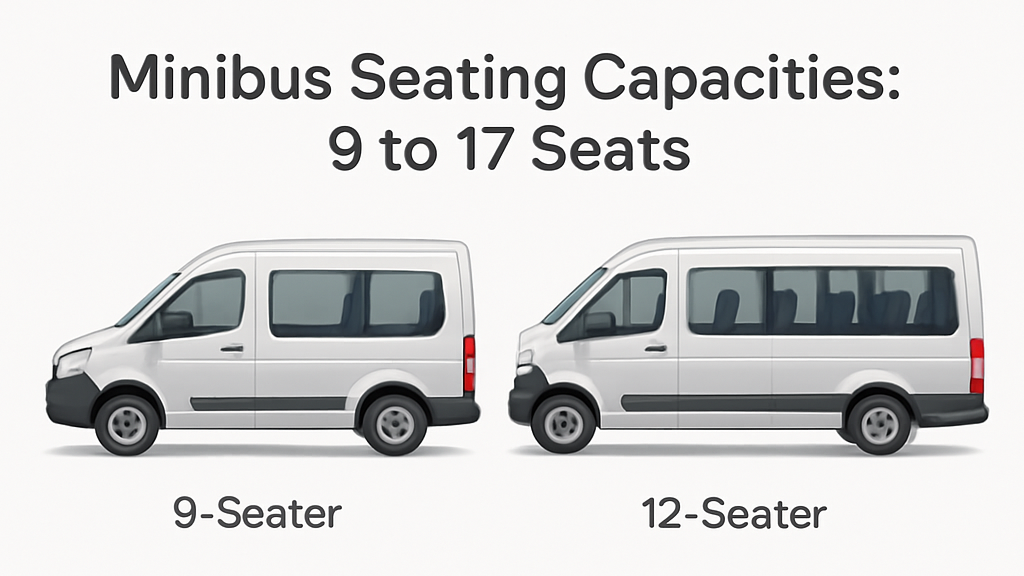
A minibus typically has between 9 and 24 seats, though the exact number can vary depending on the specific model and its intended use. Some larger minibuses, sometimes referred to as midibuses, can accommodate up to 30 passengers.
If you’re planning a trip with a group of people, a family outing, or a business event you might be wondering: How many seats does a minibus have? The number of seats in a minibus can vary, so it’s important to know what works best for your group.
In this guide, we’ll break down the different types of minibuses and their seating capacities to help you choose the right one for your needs, whether it’s for a small group trip or a larger event.
What Is a Minibus?
A minibus is a small to medium-sized vehicle designed to transport passengers. It is typically larger than a car or van but smaller than a full-size bus. Minibuses are ideal for transporting groups of people, making them perfect for event group travel or tours where a full-sized bus might be too large. It’s commonly used for various purposes, such as:
- Group transportation: Tours, events, family outings.
- School transport: Field trips, daily commuting for students.
- Private hire: Weddings, parties, corporate events.
Minibuses differ from regular cars and buses, with sizes typically ranging between a large car and a full-sized bus. But when it comes to the number of seats, this is where things get interesting.
How Many Seats Does a Minibus Have? The Standard Range
Minibuses come in various sizes depending on the manufacturer and model. Generally speaking, minibuses can accommodate 8 to 25 passengers comfortably. Below is a breakdown based on common configurations:
- 8 to 10 Seats: These are compact minibuses often used for small groups, such as a family outing, airport transfers in Farnborough, or shuttle services.
- 12 to 16 Seats: The most common configuration, especially for private hire, group travel, and school buses.
- 20 to 25 Seats: Larger minibuses that can be used for bigger groups, such as tour groups or corporate events.
These seating numbers are based on standard configurations. However, the final capacity may vary slightly depending on the specific model and manufacturer. For instance, certain minibuses might have extra legroom, luggage storage, or additional features that could affect the seating capacity.
Factors That Affect Minibus Seating Capacity
When calculating the number of seats in a minibus, several factors need to be considered:
- Vehicle Design: Some minibuses are designed with more space for luggage, making the seating area a bit smaller. Others might prioritize extra comfort for each passenger, reducing the overall capacity.
- Regulations: Different countries and states have their own regulations about passenger vehicles. In some cases, vehicles with a higher seating capacity may need additional safety features or a special driver’s license to operate.
- Purpose of Use: Some minibuses are designed for specific purposes, like school transportation, and may have specialized seating arrangements that cater to the age and needs of passengers.
- Custom Modifications: It’s important to note that minibuses can be modified for specific needs, such as adding extra seating or customizing the interior for comfort. This can impact the overall seating capacity.
Types of Minibuses and Their Seating Capacities
There are several types of minibuses, each designed for specific purposes. The most common types of minibuses and their seating capacities include:
A. Standard Minibuses
These are the most common type of minibus, and they usually have seating arrangements ranging from 8 to 17 passengers. They are ideal for small group travel and short-distance trips.
B. Midi Buses
Midi buses, often confused with minibuses, can seat between 20 to 25 passengers. These are typically used for longer trips or larger groups, and they offer more space for comfort.
C. Luxury Minibuses
Luxury minibuses are designed for comfort, often featuring plush seats, climate control, and entertainment systems. These typically seat fewer passengers (8-16), but the ride quality is far superior.
Choosing the Right Minibus for Your Needs
When selecting a minibus, the number of seats is just one consideration. There are several other factors to take into account:
A. Travel Distance
For longer journeys, you may want a minibus with more comfort features such as extra legroom, high-back chairs, and air conditioning. A minibus with fewer seats but more comfort may be preferable for longer trips.
B. Budget
Minibuses come in a wide price range. Generally, the larger the seating capacity, the higher the price— especially when you compare minibus vs MPV hire. However, you should also consider the cost of additional features like entertainment systems, luxury seats, or customized interior options.
C. Accessibility
If you’re transporting people with disabilities, a minibus with specialized features like a wheelchair lift, extra-wide doors, or adjustable seating might be the best choice.
Conclusion
In summary, a minibus can have anywhere from 8 to 30 seats, depending on its design and intended purpose. If you’re renting a minibus for a short trip or purchasing one for regular use, it’s essential to consider factors such as comfort, luggage space, and accessibility. The right minibus can make all the difference in ensuring your group travels comfortably, efficiently, and safely.

Leave a Reply
You must be logged in to post a comment.